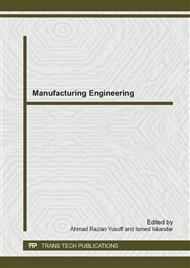[1]
T. -Y. Chiou, H.K. Chan, F. Lettice and S. H. Chung, The influence of greening the suppliers and green innovation on environmental performance and competitive advantage in Taiwan, Transportation Research Part E. 47 (2011) 822-836.
DOI: 10.1016/j.tre.2011.05.016
Google Scholar
[2]
Y. -S. Chen, S. -B. Lai and C. -T. Wen, The influence of green innovation performance on corporate advantage in Taiwan, Journal of Business Ethics. 67 (4) (2006) 331-339.
DOI: 10.1007/s10551-006-9025-5
Google Scholar
[3]
Q. Zhu, J. Sarkis and K. -h. Lai, Green supply chain management implications for closing the loop, Transportation Research Part E. 44 (2008) 1-18.
DOI: 10.1016/j.tre.2006.06.003
Google Scholar
[4]
Y. -S. Chen, The driver of green innovation and green image - green core competence, Journal Business Ethics 81(3) (2008) 551-543.
DOI: 10.1007/s10551-007-9522-1
Google Scholar
[5]
M. E. Porter and C. Linde, Green and competitive, Harvard Business Review. 73(5) (1995) 120-134.
Google Scholar
[6]
OECD, Oslo Manual: Guidelines for collecting and interpreting innovation data, Paris: OECD/European Communities, (2005).
DOI: 10.1787/9785760201737-ru
Google Scholar
[7]
A. Reid and M. Miedzinski, Eco-innovation: Final report for sectoral watch, Europe: Technopolis Group, (2008).
Google Scholar
[8]
B. M. Beamon, Designing the green supply chain, Logistic Information Management. 12(4) (1999) 332-342.
DOI: 10.1108/09576059910284159
Google Scholar
[9]
Q. Zhu and J. Sarkis, Relationships between operational practices and performance among early adopters of green supply chain management practices in Chinese manufacturing enterprises, Journal of Operations Management. 22(3) (2004) 265-89.
DOI: 10.1016/j.jom.2004.01.005
Google Scholar
[10]
E.E. Smith and S. Perks, A perceptual study of the impact of green practice implementation on the business functions, Southern African Business Review. 14(3) (2010) 1-29.
Google Scholar
[11]
R. Richey, S. Genchev and P. Daugherty, The role of resource commitment and innovation in reverse logistics performance, International Journal of Physical Distribution & Logistics Management. 35(4) (2005) 233-257.
DOI: 10.1108/09600030510599913
Google Scholar
[12]
R.G. Richey, H. Chen, S.E. Genchev and P.J. Daugherty, Developing effective reverse logistics programs, Industrial Marketing Management. 34(8) (2005) 830-840.
DOI: 10.1016/j.indmarman.2005.01.003
Google Scholar
[13]
J. Uebersax, Statistical Methods for Diagnostic Agreement, John Uebersax Enterprises LLC, Retrieved November 2, 2012, from http: /www. john-uebersax. com/stat/agree. htm.
Google Scholar
[14]
J.R. Landis and G.G. Koch, The Measurement of Observer Agreement for Categorical Data, International Biometric Society. 33(1) (1977) 159-174.
Google Scholar


